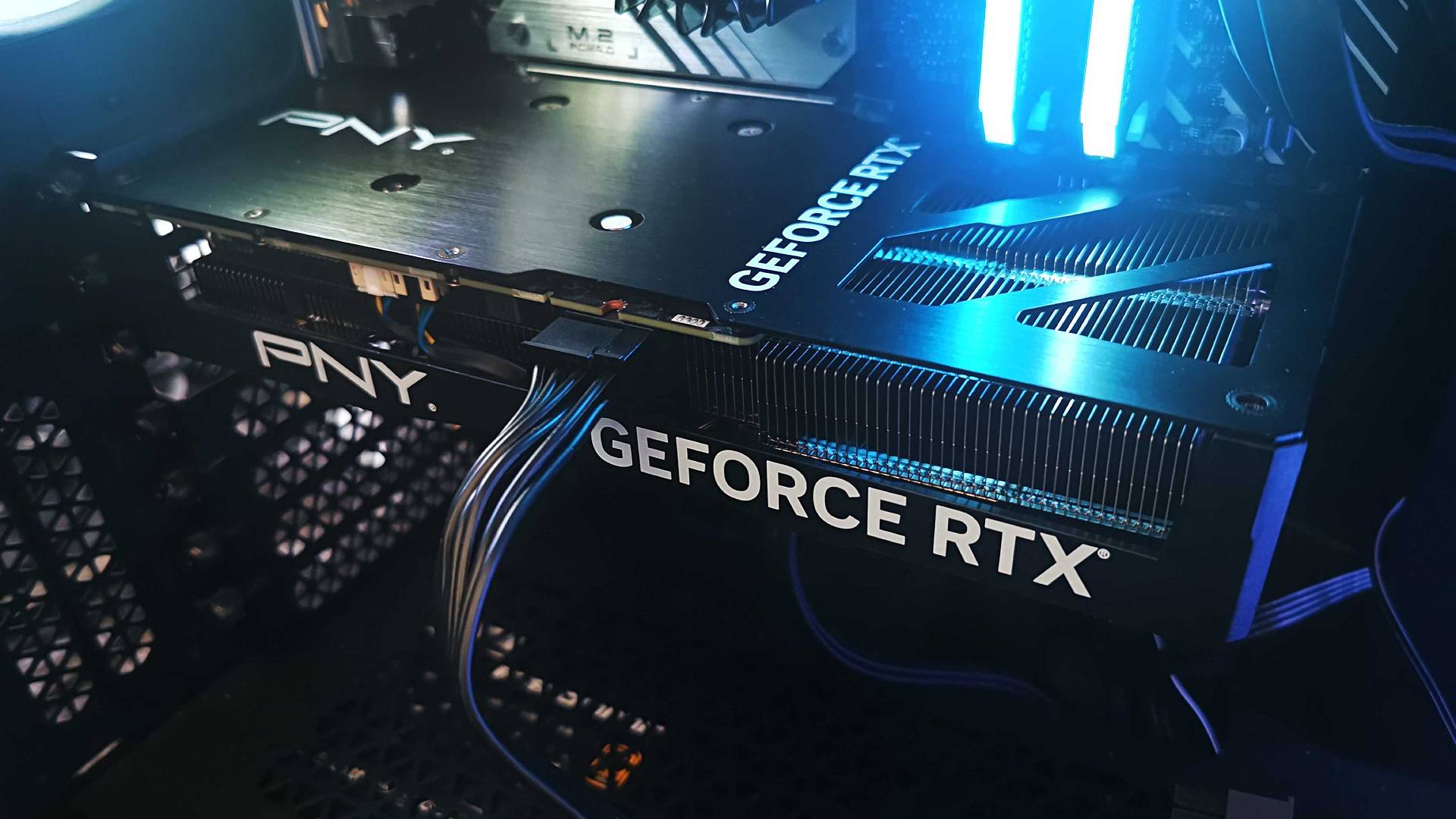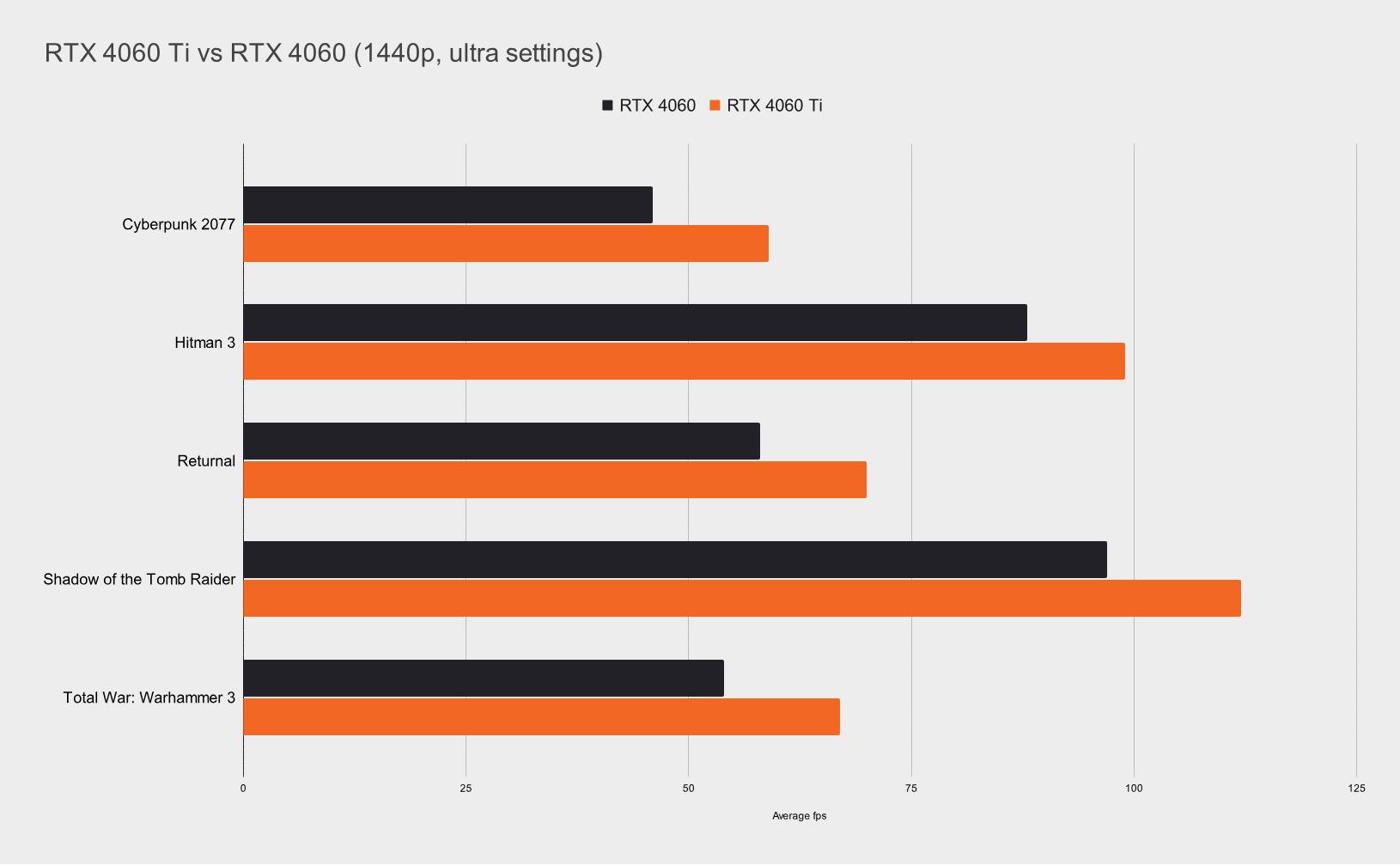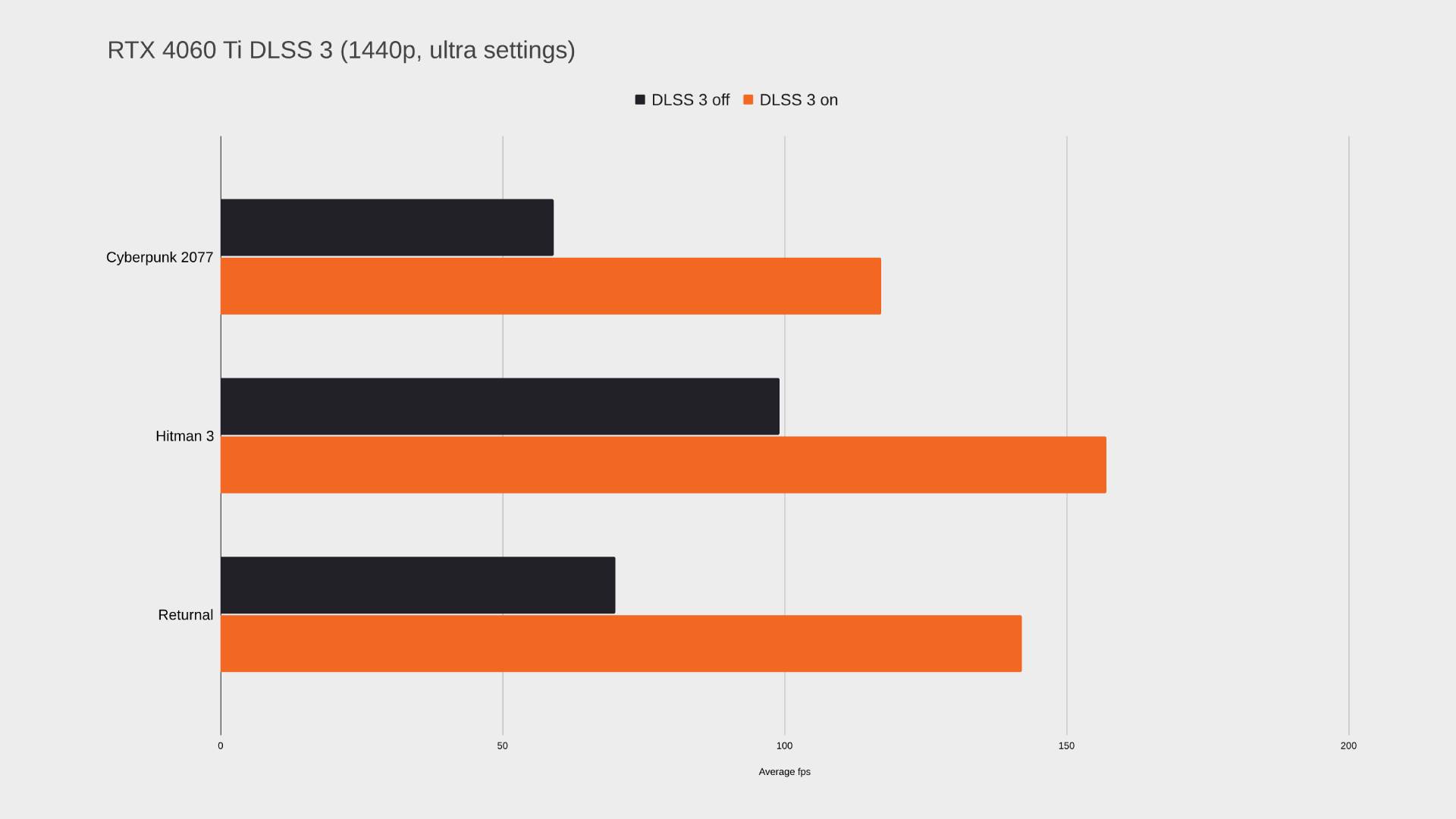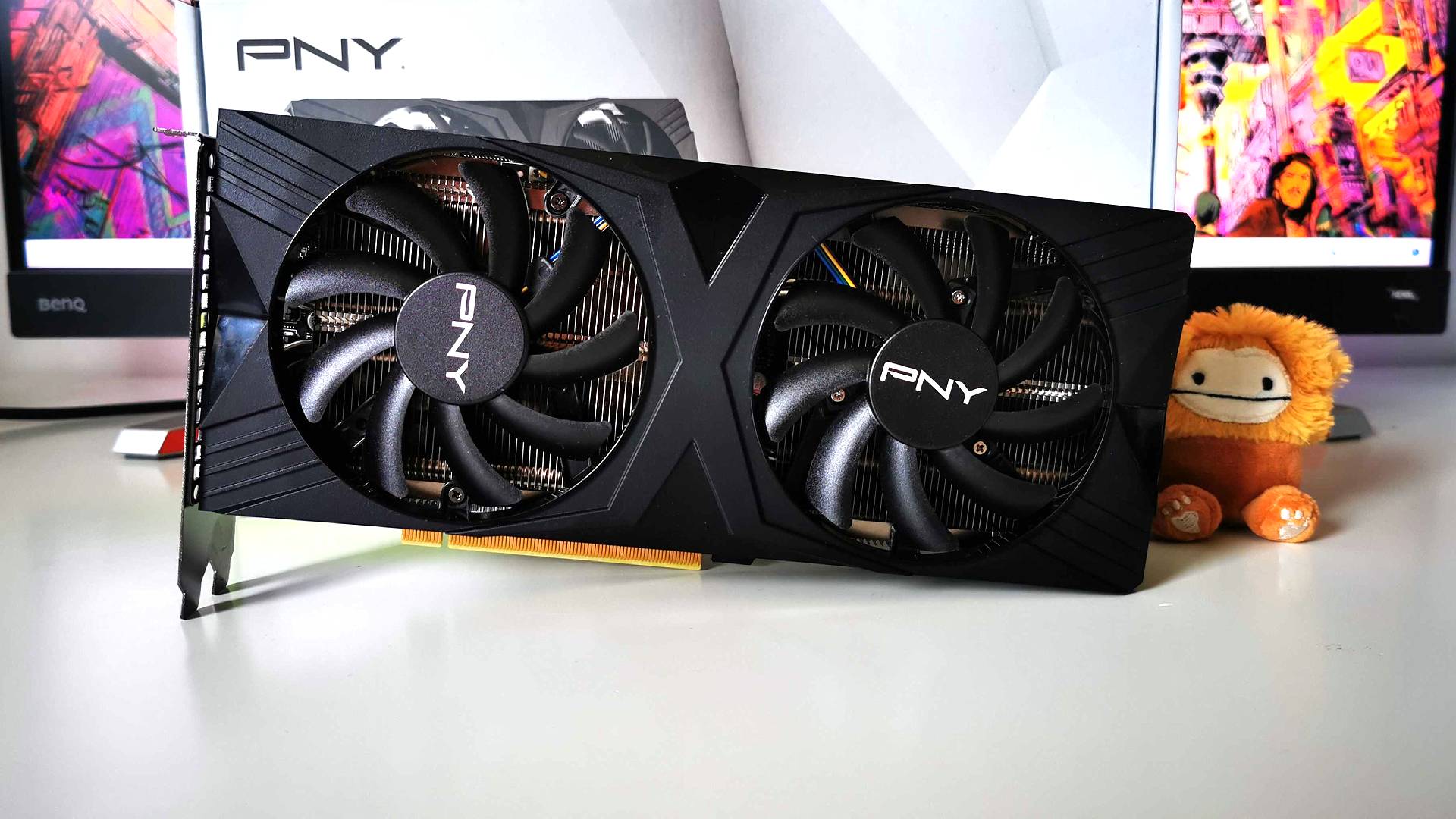GamesRadar+ Verdict
The Nvidia GeForce RTX 4060 Ti is a decent mid range graphics card that excels at 1080p gaming, but can also pull off 1440p using DLSS 3. It offers an appropriate performance uplift over and above the vanilla RTX 4060, but it’ll cost you $100 more and doesn’t completely blow its lower-spec sibling out of the water.
Pros
- +
Exceptional 1080p performance
- +
Great 1440p experience using DLSS 3
- +
Efficient cooling
Cons
- -
Only 8GB VRAM
- -
Cost $100 more than non-Ti
- -
Narrow performance gaps in some games
Why you can trust GamesRadar+
I’ve got complicated feelings about the Nvidia GeForce RTX 4060 Ti, and testing it for this review has really stirred the pot. That’s not to say it’s a bad graphics card, as it offers up decent native performance and a DLSS 3 boost where available in compatible games. However, while it’s a comfy 1080p GPU, I’m still salty about the price, and the fact it only wields 8GB VRAM is partly what keeps it from being a go-to midrange PC solution.
That might sound like I'm being a little unfair on the RTX 4060 Ti, but hear me out before you reach for your pitchforks. In fact, I’ll confuse things by saying that this souped up variant is almost one of the best graphics cards out there for 1080p gaming. However, the fact it costs $100 more than the vanilla GeForce RTX 4060 makes it incredibly hard to recommend to most players, as while it can boost fps further than its lower powered sibling, I’m not fully convinced it offers enough to justify the extra cost for everyone.
To some, $399 might not sound like a lot for the RTX 4060 Ti, but that $100 difference is a big deal if you’re on a tight budget. It could affect whether you invest in other vital parts for your build, like a new SSD or some more RAM to meet Starfield system requirements. Getting nitty gritty with pricing is essential when you’re building or maintaining an entry-level/mid-range gaming PC, and while the card’s performance holds up, it probably won’t revolutionize your experience.

Specs
At a glance, the RTX 4060 Ti specs look fairly similar to the non-Ti version. Both cards feature 8GB GDDR6 VRAM and a 128 bit memory bus. The main difference relates to Nvidia’s choice of chip, as the souped up model is armed with an AD106 GPU rather than a AD107. That former option packs 4,352 CUDA cores, 136 Tensor cores, and 34, which is a substantial uplift over and above the vanilla RTX 4060.
| Price | $399 |
| GPU | AD106 |
| CUDA cores | 4,352 |
| Tensor cores | 136 |
| RT cores | 34 |
| Base clock | 2,310MHz |
| Boost clock | 2,535MHz |
| VRAM | 8GB GDDR6 |
| Memory bus | 128-bit |
As for power, the RTX 4060 Ti comes with a higher 160W TDP, and a 400W PSU is recommended. Chances are you’ll end up using something beefier than that, but it’s worth keeping in mind if you’re on the hunt for a lightweight GPU for a smaller build. On that note, the 4060 Ti opts to use a traditional 8-pin connector rather than the new 16-pin socket paired with a dongle, something that really helps when it comes to tight cable management.
It’s worth noting that there is now a 16GB version, but the model I’m testing for review is the 8GB PNY GeForce RTX 4060 Ti. Just like with most Nvidia cards in 2023, there’s no Founder’s Edition, so all available models are produced by a board partner. That’s not by any means a bad thing, as these savvy manufacturers know a thing or two about custom cooling, and PNY is no exception.

Design
Normally I have lots of say when it comes to graphics card aesthetics, but PNY opts for an extremely subtle approach with its RTX 4060 Ti design. The card wears a minimalist plastic shroud and metal backplate, brandished with bold white text on the top and sides. There are prettier versions out there, like a XLR8 Gaming Verto model that's clad with RGB, so the company is less copping out on the design front and more maintaining a subtle option for builders looking to keep things stealthy.
Features
Looks aside, the PNY RTX 4060 Ti is armed with a dual fan cooling system, and it feels more appropriate than triple fan alternatives. I’ll get onto thermals in a little bit, but the GPU maker has seemingly struck a good balance between card size cooling efficiency. Not that this card is remotely large compared to Nvidia’s monstrous high end trio, but I appreciate companies keeping entry-level and midrange cards on the dinky side.
Round the back, you’ll find three DisplayPorts and one HDMI, just like with most other new-gen GPUs. I’ve been thinking a lot recently about how the AMD Radeon RX 7900 XT and XTX features a USB-C port, and it’s something I’d like to see in lower spec cards in the future. I guess I view these cards as being well suited to smaller ITX builds, and using less chonky cables sort of makes sense.

Performance
I’m not disappointed with the RTX 4060 Ti on the performance side of things, and benchmark results sort of line up with my initial expectations. My tests effectively confirm that it’s a 1080p card for players who don’t want to remotely compromise on settings, with additional DLSS 3 superpowers transforming it into a makeshift 1440p solution. However, the same technically goes for the non-Ti version, and the frame rate gaps on display aren’t the completely deciding factor I’d hoped they’d be.
| Game | 1080p | 1440p | 1440p + Ray Tracing (DLSS 3 on) |
|---|---|---|---|
| Cyberpunk 2077 | 95fps | 59fps | 87fps |
| Hitman 3 | 105fps | 99fps | 91fps |
| Returnal | 98fps | 70fps | 117fps |
| Shadow of the Tomb Raider | 141fps | 112fps | - |
| Total War: Warhammer 3 | 104fps | 67fps | - |
To kick things off, let's home in on Cyberpunk 2077 benchmarks, as the ravenous RPG piles on enough pressure to make things interesting. Without AI upscaling assistance, the RTX 4060 Ti can pump out 95fps on average at 1080p, a 25% increase compared to the vanilla RTX 4060. DLSS 3 ramps that figure up to 161fps, which is good news for anyone rocking one of the best gaming monitors with a higher refresh rate than 144Hz.
OpenCL: 134,909
Vulkan: 124,740
Time spy: 12,273
Firestrike: 26,285
That gap sadly isn’t consistent across all of our benchmarks, as Hitman squeezes 105fps at 1080p out of the RTX 4060 Ti compared to 100fps when paired with the non-Ti card. A pretty minor increase, but DLSS enhanced results place more distance between the two cards, which is likely linked to the increase in Tensor cores.
Shadow of the Tomb Raider is another game that provided weirdly close benchmarks, as there’s only 10fps of a difference between the RTX 4060 Ti and RTX 4060 at 1080p. I’ve got a sneaking suspicion that Lara’s adventure would benefit from a bit more VRAM headroom, but I can’t prove that for sure since I’ve not tested the 16GB model. I experienced even more shenanigans while testing Returnal, as for whatever reason, I was only able to boost fps by around two frames. Perhaps there’s something funky going on under the hood of the PS5 port, but switching on DLSS 3 weirdly produces the difference I was expecting.


I typically use Total War: Wahammer 3 as a native performance indicator, as the RTS romp lacks any sort of AI upscaling support. It’s also just pretty demanding when played at higher resolutions, and highlights any GPU shortcomings effectively. At 1440p, the RTX 4060 Ti manages to pull off a respectable 67fps average, leaving the non-Ti behind in the sub-60fps dirt. If the idea of double digit frame rates repulses you, stepping things back to 1080p will hike things above 100fps, but don’t expect next-generation visuals if you choose to do so.
When it comes to ray tracing performance, I’m actually fairly impressed with the RTX 4060 Ti. Don’t get me wrong, it won’t fearlessly take on 4K workloads with fancy lighting enabled, but if you’re willing to embrace DLSS 3, you’re looking at a decent 1440p experience with frame rates comfortably above 60fps. I should probably reiterate that this card is designed with 1080p in mind, and dialing back will provide a native boost, but it’s nice to know where to draw the line in terms of performance.
If you’re wondering how RTX 4060 Ti thermals hold up, I’m pleased to report that PNY’s card understands the assignment. Even while stressing the GPU out with my chaotic Baldur’s Gate 3 run, temperatures rarely creeped above 60°C, and the same applies to the above benchmark tests. That’ll hopefully provide some confidence to builders looking to squeeze this model into a dinky case, and I can see it providing decent temps as part of a mini-ITX setup.
It’s safe to say the RTX 4060 Ti packs more of a performance punch than RTX 4060, but the above benchmark inconsistencies are a little baffling. Your mileage may vary depending on your choice of game, and it’s worth noting that the non-Ti used for comparison is a factor overclocked MSI model. Nevertheless, I’m used to seeing wider gaps between GPU tiers, and it makes deciding between the two cards a bit more complicated.

Should you buy the Nvidia GeForce RTX 4060 Ti?
If you’re looking to boost PC performance as much as possible for under $400, the RTX 4060 Ti is your go-to Nvidia option. That said, it faces stiff competition from both the AMD Radeon RX 7600 and Intel’s Arc A770, especially since the latter offers 16GB VRAM for the same price. Sure, Nvidia’s card still has the performance edge, and DLSS 3 offers serious frame boosting magic tricks, but the fact it doesn't completely blow its rivals out of the water prevents it from being a default option for mid range gaming PCs in 2023.
Still, the RTX 4060 Ti is a great 1080p GPU that’ll serve as a great upgrade if you’re rocking an older card, and PNY’s version pairs effective cooling with decent build quality. You’ll have to look elsewhere if you’re looking for something flashier, but if you’re happy with subtlety, you’ll be able to grab this model for MSRP.
How I tested the Nvidia GeForce RTX 4060 Ti
For two weeks, I used the RTX 4060 Ti in place of my usual graphics card for carrying out work duties and playing PC games. While I carried out quantitative benchmarks using Cyberpunk 2077, Hitman 3, Returnal, Shadow of the Tomb Raider, and Total War: Warhammer 3, I also played a chunk of Baldur’s Gate 3 using the GPU. I also used my experience testing various other Nvidia options to assess the card’s performance and abilities to determine if it offers good value for money.
If you'd like to learn more about how we how we test graphics cards and everything else gaming tech related, check out the full GamesRadar+ Hardware Policy.
Prefer to stick to pre-builds? Check out the best Alienware gaming PCs with out of this world GPUs already inside. Alternatively, take a peek at the best gaming laptops if you're looking for a portable powerhouse.

Phil is the Hardware Editor at GamesRadar and joined the team in 2023. In the past, they've also contributed to the likes of TechRadar, The Daily Star, the BBC, and PCGamesN, but these days, they specialize in testing the latest gaming handhelds, monitors, TVs, and PC components. They're also extremely nerdy about retro consoles and playing the classics on both new and old systems.



